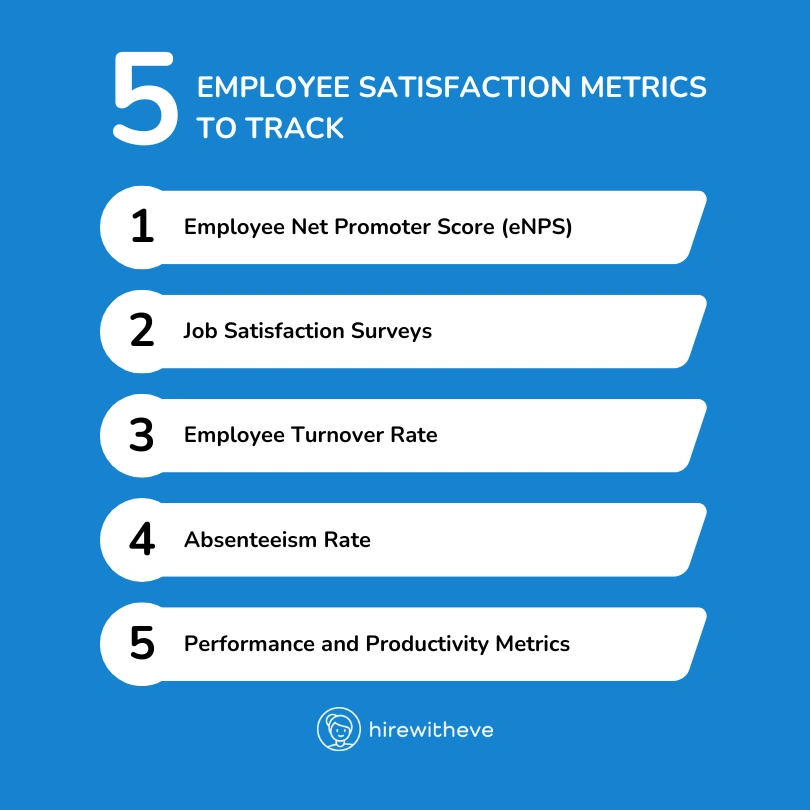Top 5 Most Useful Employee Satisfaction Metrics to Track
Top 5 Most Useful Employee Satisfaction Metrics to Track

In today’s competitive landscape, happy employees aren’t just a nice-to-have — they’re a necessity for business success.
Employee satisfaction plays a pivotal role in driving productivity, enhancing retention, and cultivating a positive workplace culture. However, to truly understand how engaged your workforce is, it’s crucial to track the right metrics.
In this blog, we’ll explore the top 5 most useful employee satisfaction metrics every company should monitor to ensure their teams feel valued, motivated, and aligned with company goals.
Table of contents
What is Employee Satisfaction?
Employee satisfaction refers to the level of contentment and fulfillment that employees feel regarding their job and work environment.
It includes various aspects such as job roles, workplace culture, relationships with colleagues and supervisors, opportunities for professional development, and work-life balance. High employee satisfaction often leads to increased productivity, lower turnover rates, and a more positive organizational culture.
For instance, consider a software development company where employees frequently express their satisfaction through anonymous surveys. They report feeling valued due to regular feedback from management, access to professional development resources, and a supportive team atmosphere.
This satisfaction translates into higher engagement levels, evident in their willingness to collaborate on projects and contribute innovative ideas during team meetings.
What Is the Difference Between Employee Satisfaction and Employee Engagement?
Employee satisfaction and employee engagement are closely related concepts, but they focus on different aspects of the employee experience:
Employee Satisfaction
Employee satisfaction refers to how content and happy employees are with their job, workplace conditions, and benefits. It assesses whether employees’ needs and expectations are being met.
Focus: Primarily concerned with the immediate feelings of employees regarding their work environment and conditions.
Indicators: Common indicators include job security, salary, work-life balance, and relationships with coworkers. For example, an employee may feel satisfied if they receive a competitive salary and enjoy a comfortable office environment.
Outcome: High employee satisfaction can lead to retention, but it doesn’t necessarily indicate that employees are committed or passionate about their work.
Employee Engagement
Employee engagement goes beyond satisfaction to measure how emotionally invested employees are in their work and the organization. It reflects their level of enthusiasm, motivation, and commitment to their roles.
Focus: Focuses on the emotional connection and involvement employees have with their work and the organization’s goals.
Indicators: Indicators of engagement include employee advocacy, willingness to go above and beyond, enthusiasm for the job, and a desire to contribute to the organization’s success. For example, an engaged employee actively participates in team projects and seeks out ways to improve processes.
Outcome: High employee engagement leads to greater productivity, innovation, and overall organizational success, as engaged employees are more likely to be proactive and contribute positively to their teams.
Top 5 Employee Satisfaction Metrics to Track
Here are the top five employee satisfaction metrics to track for understanding and improving the overall satisfaction levels within your organization:

Employee Net Promoter Score (eNPS)
This metric measures how likely employees are to recommend your organization as a great place to work. It gauges overall employee sentiment.
Here are some example eNPS scores from well-known companies:
HubSpot: 74
Apple: 18
Johnson & Johnson: 25
Revolut: -36
Ryanair: -15
How to Track: Employees rate their likelihood to recommend the company on a scale of 0-10. Responses are categorized into promoters (9-10), passives (7-8), and detractors (0-6). Subtract the percentage of detractors from promoters to get the eNPS.
Job Satisfaction Surveys
Regular surveys that assess various aspects of job satisfaction, such as work conditions, compensation, management support, and job roles.
How to Track: Use a mix of quantitative (rating scales) and qualitative (open-ended questions) formats. Analyze the responses to identify areas of improvement and strengths.
Employee Turnover Rate
This metric tracks the rate at which employees leave the organization voluntarily or involuntarily.
How to Track: Calculate turnover by dividing the number of employees who left during a specific period by the average number of employees in the same period. A high turnover rate may indicate dissatisfaction.
Absenteeism Rate
This measures the frequency and reasons for employee absences, which can indicate satisfaction levels.
How to Track: Calculate absenteeism by dividing the total number of absent days by the total number of scheduled workdays, then multiply by 100 to get a percentage. High absenteeism can signal disengagement or dissatisfaction.
Performance and Productivity Metrics
Tracking employee performance and productivity can provide insights into their satisfaction levels, as satisfied employees are generally more productive.
How to Track: Use performance appraisals, project completion rates, or sales numbers as indicators. Regular check-ins and feedback can also highlight levels of motivation and satisfaction.
Conclusion
Tracking employee satisfaction metrics is essential for fostering a positive workplace environment and enhancing overall organizational performance.
By regularly assessing factors such as job satisfaction, employee feedback, and retention rates, companies can identify areas for improvement and make informed decisions to boost morale and productivity.
HirewithEve can support this journey by providing tailored hiring assessments and tools that help organizations select candidates who align well with their culture and values, ultimately contributing to a more satisfied and engaged workforce.
Target Your Talent
Unlock tailored solutions for your recruitment and hiring needs with Eve Platform's extensive case study library.
Subscribe now to enhance your HR expertise and excel in your role.
Free Resources

Transforming Hiring: 7 Key Recruiting Metrics
Enhancing recruitment processes with data-driven insights for better hiring outcomes.

Reducing Hiring Bias with Hirewitheve.
Utilizing Hirewitheve to combat bias and streamline recruitment processes effectively.

Hiring Detail-Oriented Candidates
HirewithEve enhances hiring by accurately assessing candidate's attention to detail-oriented.
